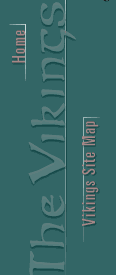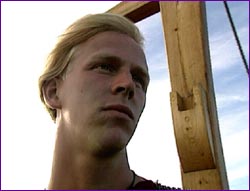
|

|
For centuries—indeed, ever since Viking raiders savagely attacked England's Lindisfarne monastery in A.D. 793—the Vikings have seemed to many to have been little more than blue-eyed barbarians in horned helmets. But archeological investigations of Viking sites stretching from Russia to Newfoundland have revealed a more human (if not altogether humane) side to the Viking character. In this interview with NOVA producer Julia Cort, William Fitzhugh, curator of a new exhibit on Vikings at the Smithsonian Insitution, offers compelling insight into this new image of the Norsemen and what he perceives as their catalytic role in Europe's transformation from a feudal society to an integrated group of modern nation-states. NOVA: What must it have been like for the monks at Lindisfarne to be suddenly attacked out of the blue? Fitzhugh: For them, the attack represented the vengeance of Satan on the Christian outposts of Europe. It was a terrible event, because the monks and the church centers had set themselves up in small, fortress-like places where they could pursue their studies and writings in peace, and it was an invasion of the sanctitude of Christ and their religion. This was totally unlike anything that had happened before. There had been outlaws, but to have shiploads of brawny characters show up at your isolated, supposedly sacred center, this was the ultimate horror. NOVA: What did the Vikings actually do in these attacks?
NOVA: Did they kill a lot of people in these raids? Fitzhugh: In many cases they did. I think they were relatively ruthless, but remember, this was a ruthless age with far more than just peaceful farmers living peaceful lives. All sorts of things were going on in the British Isles and mainland Europe, including constant battles between rival princes vying for kingship and control of local regions. The Vikings were just another crowd, though a crowd that was non-Christian and had no compunction about killing churchmen or women or children.
NOVA: So what are the main challenges in finding the truth about the Vikings? Fitzhugh: Well, one of the major problems in Viking studies is that we're biased towards the historical accounts—early chronicles that all came from the church centers or official reports to the kings or regional authorities. It's always been that way. Only in the past 20 years or so have archeological and other studies begun to provide information that fleshes out and in some cases contradicts or even replaces the historical record. These findings are giving us a totally different view of the Vikings. We see them archeologically not as raiders and pillagers but as entrepreneurs, traders, people opening up new avenues of commerce, bringing new materials into Scandinavia, spreading Scandinavian ideas into Europe. For instance, we see silk that originated in Asia appearing in archeological sites such as that at York (see The Viking Diaspora). This contrasts sharply with the early accounts, which were all from Europe, were inevitably based on victims' reports, and were extremely one-sided. Continue: The Icelandic Sagas Explore a Viking Village | Who Were the Vikings? Secrets of Norse Ships | The Viking Diaspora Write Your Name in Runes | Build a Tree-Ring Timeline Resources | Transcript | Site Map | The Vikings Home Editor's Picks | Previous Sites | Join Us/E-mail | TV/Web Schedule About NOVA | Teachers | Site Map | Shop | Jobs | Search | To print PBS Online | NOVA Online | WGBH © | Updated November 2000 |


